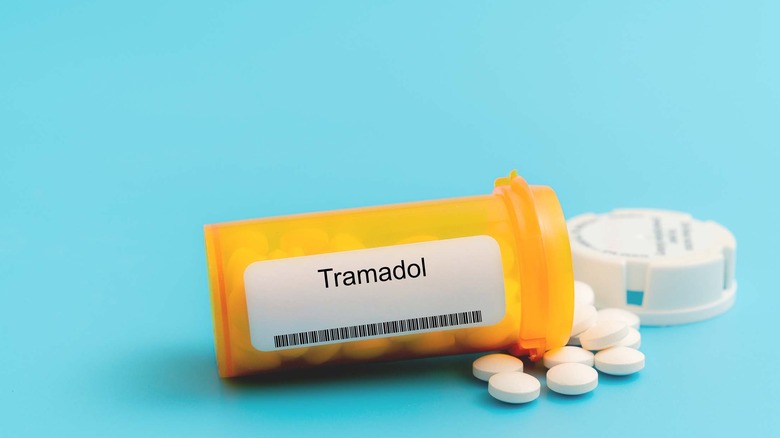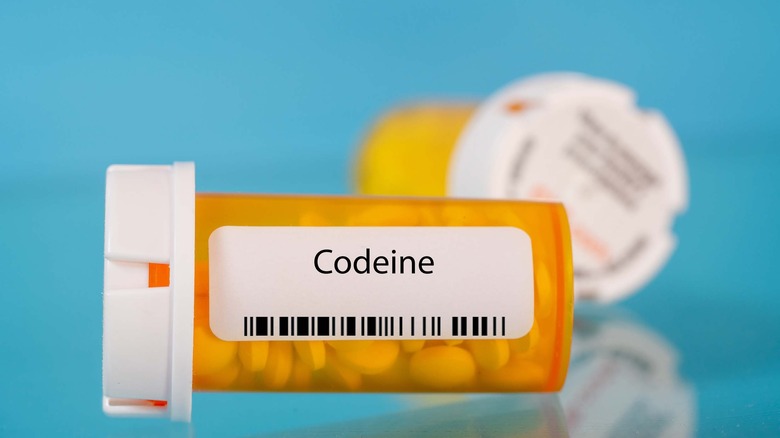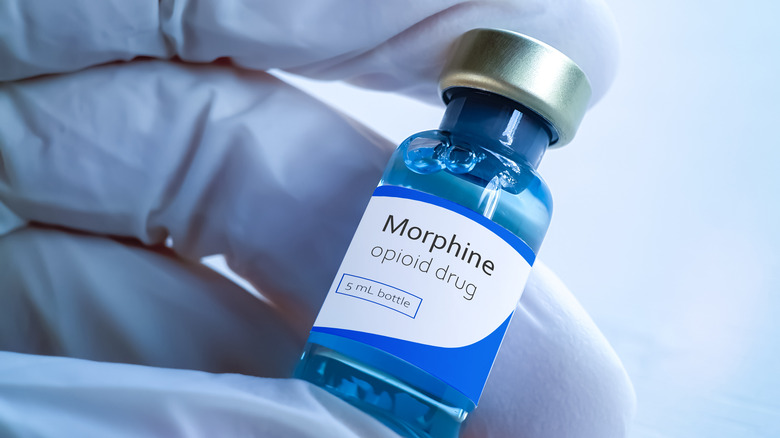Tramadol Explained: Usage, Doses, And Side Effects
Whether you just had surgery, are injured, or are dealing with a painful chronic condition, living with debilitating pain is just not an option. Thus, depending on the reason, your healthcare provider might consider prescribing some kind of pain medication such as tramadol. Tramadol was approved back in 1995 as a synthetic opioid medication used to treat mild to severe pain, like the type of pain you'd expect from a medical procedure or long-term conditions such as osteoarthritis or fibromyalgia, as well as other types of pain, such as back pain or cancer-related pain (per Harvard Health Publishing).
Being a synthetic opioid means that tramadol is chemically similar to natural opioids like codeine and morphine, yet rather than being extracted from specific varieties of the poppy plant, it was created in a lab. Thus, tramadol works by binding to opioid receptors in the brain, which can reduce the sensation of pain, according to the Drug Enforcement Administration (DEA). However, despite having been approved by the U.S. Food and Drug Administration (FDA) for medical use, tramadol and other synthetic opioids can also be habit-forming and can lead to addiction or overdose if used improperly. Therefore, it is essential to only use them under the guidance of a healthcare provider and to follow their instructions carefully (via Medical News Today). This article reviews tramadol, including how it works, its side effects, and other alternatives for pain management.
How does pain work in the body?
Despite being an unpleasant experience, pain is your body's way of telling you that something is either damaged or not working properly. According to Physiology, Pain, it helps minimize tissue damage from external factors, meaning that pain helps to protect injured tissues by causing you to avoid or limit movements that could further damage the affected area. Without pain, you would be unaware of injuries, infections, or other conditions that require medical attention, which makes it essential for survival and well-being. The sensation of pain is generated when specialized nerve cells called nociceptors detect thermal (hot or cold), mechanical (a blow, pressure, or cut), or chemical (inflammatory compounds produced by the body) stimuli released by injured or inflamed tissues. When these nociceptors (which are located throughout the body) are activated, they send a signal through the nervous system to the spinal cord and then to the brain, where the sensation of pain is processed.
While there are multiple types of pain that vary according to their cause or place of origin, pain can be broadly classified as acute or chronic, depending primarily on its duration. Acute pain is the immediate result of an injury. It can be easily located and has a relatively short duration. In contrast, chronic pain is a persistent pain associated with inflammatory responses from diseases or conditions such as arthritis or cancer (via Britannica). Since chronic pain can be a significant burden on individuals and society, leading to disability, decreased quality of life, and increased healthcare costs (per the U.S. Pain Foundation), pain management is an essential goal of healthcare providers. It can involve a range of interventions that might include prescription medications like tramadol.
How does tramadol work?
Tramadol is a synthetic opioid prescription medication that works by binding to opioid receptors in the central nervous system (CNS), which consists of the brain and spinal cord (via the Mayo Clinic). When taken orally, it is rapidly and almost completely absorbed into the bloodstream (about 75%, per Drugs.com), which is how it reaches the brain, and, ultimately, its target receptors.
By binding to opioid receptors, tramadol causes a blockage in the pain transmission pathways, which reduces the sensation of pain. However, it also has additional effects on other neurotransmitters in the brain (compounds that act as messengers among nerve fibers). In addition to inhibiting pain, tramadol also inhibits the reabsorption of the neurotransmitters serotonin and norepinephrine, which can increase their concentration in the brain. Serotonin and norepinephrine are involved in regulating mood, anxiety, and your body's fight-or-flight response, so the increased availability of these neurotransmitters may contribute to tramadol's additional effects on mood and anxiety, as well as some of its potential for side effects (via Medicine.com).
Tramadol dosage and directions
Tramadol comes in multiple forms, including standard or immediate-release and slow or extended-release tablets and capsules, oral drops, soluble tablets, tablets that disintegrate in the mouth, and injections, per the National Health Service (NHS). Each available form comes in a different dosage. However, its dosage and directions can vary depending on each person's age, medical condition, and other factors such as pain severity and tolerance. Therefore, it is critical to always follow the specific instructions provided by your healthcare provider.
Ideally, tramadol should be taken at the lowest possible dose for the shortest possible time. This means your doctor will likely start you out with a 25-mg dose for standard tablets and capsules and increase it by 25 mg as needed every three days. If you still need a higher dosage after reaching 100 mg per day, you may increase the dose in 50-mg increments every three days until reaching a total of 200 mg per day. If a higher amount is still needed, you may increase it by 100 mg until reaching the maximum recommended dosage of 400 mg per day (per Drugs.com). However, the recommended dosage may be lower for older adults or those with certain medical conditions, such as liver or kidney diseases. As for the extended-release tablets and capsules, the recommended initial dose is 100 mg daily, which you can increase every five days to a maximum of 300 mg (via MedicineNet).
Tramadol may be taken with or without food. In addition, the NHS states that tramadol should be swallowed whole, and slow-release tablets and capsules should never be broken, split, or opened, as doing so would disrupt the integrity of the slow-release mechanism and increase the risk of overdose by causing a bigger dose to be released into your body all at once.
Side effects of taking tramadol
Unfortunately, like most opioid and synthetic opioid medications, tramadol comes with a long list of potential side effects, and their severity and frequency may vary depending on the individual, their medical history, and the dosage and duration of use. Common side effects include nausea and vomiting, dizziness or lightheadedness, constipation, and headaches. More seriously, tramadol may cause fatigue, loss of appetite, weight loss, sleep apnea, difficulty breathing, confusion or hallucinations, seizures, irregular heartbeat, or fainting (via WebMD).
While some of these side effects, such as nausea and constipation, may improve over time as the body adjusts to the medication, others, such as seizures or difficulty breathing, can be severe and require immediate medical attention. In addition, tramadol can cause allergic reactions in some people, leading to skin rash, hives, or throat and face swelling (per Drugs.com). Moreover, since tramadol also blocks the reabsorption of serotonin in the brain, it can lead to serotonin to build up to dangerous levels in the brain. This condition is known as serotonin syndrome or serotonin toxicity, which, as WebMD explains, can increase the risk of hallucinations, tachycardia or fast heartbeat, severe dizziness, diarrhea, nausea and vomiting, twitching muscles, fever, and agitation. Lastly, other reported side effects include lack of menstruation, lower sex drive, infertility, insomnia, vision changes, and depression-like thoughts (via Medicine.com). Keep in mind that this is not an exhaustive list of side effects. Make sure to contact your healthcare provider if you notice these or any other potential symptoms after starting tramadol.
Tramadol may interact with other drugs
Tramadol can interact with other medications, which can increase the risk of side effects or overdose or reduce its effectiveness. In fact, it is known to interact with over 647 different drugs (per Drugs.com). According to GoodRx Health, drugs like Wellbutrin or Prozac, which belong to a class of drugs known as CYP3A4 inhibitors, can keep your liver from metabolizing tramadol, which leads to dangerously high levels of the medicine. In contrast, other substances known as CYP3A4 inducers, such as St. John's wort or Dilantin, can reduce tramadol's effectiveness by causing your liver to metabolize it too fast. In addition, taking tramadol along with sedatives, sleep and anxiety medications, muscle relaxants, alcohol, anticholinergic medications, or other opioids can have a cumulative effect, increasing the risk of overdose and worsening their side effects. Furthermore, taking Tramadol with antidepressants or other medications that raise serotonin levels can increase the risk of serotonin syndrome.
What's more, GoodRx Health warns not to take tramadol with opioid antagonists (which are used to treat opioid and alcohol use disorders), as they would counteract the effect of the medicine and potentially lead to opioid withdrawal symptoms. Additionally, since tramadol may increase the risk of seizures, it is vital to avoid consuming it with other medications that also increase their likelihood. Lastly, tramadol may reduce the effectiveness of diuretics, but can increase the levels of heart medications like Warfarin and Digoxin. As you can see, it is crucial to inform your healthcare provider of all the medicines, supplements, and herbal remedies that you're taking before starting tramadol.
Some people should avoid taking tramadol
Tramadol is not suitable for everyone and should be used with caution, especially in people with certain medical conditions or who are taking specific medications. According to Drugs.com, tramadol might be dangerous to children under 12 years old and should also be avoided in teenagers under 18 years old who've had their tonsils removed. In addition, since tramadol may slow down your breathing, people with severe breathing problems are advised not to take the drug. People with severe liver or kidney disease should also avoid it, seeing that tramadol is metabolized by the first and excreted by the latter.
Furthermore, since both natural and synthetic opioids can lead to opioid-induced constipation (OIC), people with a blockage in their stomach or intestines should steer clear of tramadol to avoid serious complications (via Drugs.com). Additionally, since tramadol is considered a habit-forming drug, people with a history of substance abuse or who are prone to addiction should not take the drug, as it may lead to dependence. Lastly, tramadol may increase the risk of seizures in people who have a history of seizures or epilepsy, and those who are taking other opioid medications or antidepressants should not take tramadol due to the increased risk of drug-drug interactions. Given the long list of conditions that contraindicate the use of tramadol, it is essential to inform your healthcare provider of all medical disorders and medications that you're taking, so they can assess whether tramadol is safe and appropriate for you.
Taking tramadol may increase the risk of dependency
When Tramadol is not taken as directed (meaning that it is ingested at a larger dose than needed or for an extended period), it can increase the risk of addiction or dependence. Like all opioids, tramadol can increase the risk of dependency or addiction due to its effect on the brain's reward system. By binding to opioid receptors in the brain, Tramadol reduces the perception of pain and produces feelings of pleasure and well-being. Over time, the brain can become accustomed to these effects and may develop a tolerance to the medication, which means that higher doses are needed to achieve the same level of pain relief. Someone may also use the medication inappropriately in order to obtain its side effects, which include mood-enhancing feelings like relaxation or euphoria (via Healthline).
To reduce your risk of addiction or dependence, Health Direct suggests looking out for symptoms such as feeling the need to increase the prescribed dose to achieve the same therapeutic effects, or having a hard time controlling the medication's use, relying on it as a means to feel normal or better, or experiencing withdrawal symptoms such as anxiety, insomnia, and physical discomfort when reducing or suspending its use. Also, keep in mind that medicine dependence can happen to anyone, so be sure to stay alert for potential symptoms so that you can get the help you need right away.
Tramadol, pregnancy, and breastfeeding
According to Drugs.com, tramadol is not recommended for use during pregnancy or breastfeeding, as it may cause harm to the developing baby or newborn. While there are not enough human studies linking tramadol use during pregnancy with birth defects, animal studies have found an increased risk of problems with organ development, adequate bone growth, and even higher mortality rates when consumed in high amounts. Furthermore, evidence has established that tramadol can cross the placental barrier (meaning that if the expecting mother consumes it, it can reach the baby), which could potentially lead to stillbirth. What's more, consuming tramadol during pregnancy can lead to newborns suffering from common tramadol side effects, including withdrawal syndrome, seizures, and breathing problems.
When it comes to breastfeeding, Drugs.com explains that much like tramadol crosses the placental barrier, it can also pass into breast milk (though in lower amounts) and cause side effects in the nursing child, such as drowsiness, limpness, difficulty feeding, and slowed breathing due to their inability to metabolize the drug. Thus, if tramadol is used during breastfeeding, it is important to monitor the baby closely for any potential side effects and call emergency services immediately if you notice any of them.
Tramadol versus codeine
Tramadol and codeine are both opioid medications used to manage mild to moderate short-term pain. As such, they share multiple similarities, but there are also differences in their nature and side effect profile. For starters, Drugs.com explains that while tramadol is a synthetic opioid (meaning that it is made in a lab), codeine is a natural opioid derived from the poppy plant. They share a couple of side effects, such as constipation, confusion, dizziness, and risk of dependency that can lead to withdrawal symptoms when you suddenly stop taking them. However, codeine has a higher risk of causing breathing problems and constipation than tramadol. Yet, unlike tramadol, codeine doesn't increase the risk of seizures (via Health Direct). When it comes to their risk of addiction, the Controlled Substances Act (CSA) classifies codeine as a Schedule 2 substance, while tramadol is classified as a Schedule 4. This means that codeine has a higher potential for abuse (per Drugs.com).
As for their similarities, both tramadol and codeine can interact with other medications, but codeine interacts with fewer: According to Drugs.com, codeine interacts with 470 drugs, compared to 647 for tramadol. Lastly, both tramadol and codeine are among the less-potent opioids and are considered equally effective when it comes to pain management. They can also be combined with acetaminophen (Tylenol) when their effects are insufficient for pain relief.
Tramadol versus morphine
While both tramadol and morphine are opioid medications, they have multiple differences that play a role when deciding which drug is right for you. For instance, morphine is a natural opioid that is considered more potent than tramadol. Thus, it is preferred for the treatment of severe pain in chronic or long-term conditions, or pain caused by trauma or surgery (via Health Direct). In contrast, tramadol is typically used for the treatment of moderate pain. Consequently, given morphine's heightened painkiller effect, it is considered to have a higher risk of misuse. According to Drugs.com, morphine is classified as a Schedule 2 controlled substance per the Controlled Substances Act (CSA) in the United States. In contrast, tramadol is classified as a Schedule 4 controlled substance, which translates into a lower potential for abuse.
Both medicines can cause common side effects such as nausea, vomiting, constipation, tiredness, and skin reactions. Yet, morphine's severe side effects include fever, extreme drowsiness or sleepiness, chest pain, reduced responsiveness, and fainting (per Drugs.com), while tramadol has an increased risk of seizures. Finally, both drugs can interact with other medications you might be taking. Keep in mind that choosing one over the other will depend on the severity of the pain, individual patient factors, and the potential risks and benefits of each medication, which is something you should discuss with your healthcare provider.
Alternatives to tramadol
Sometimes, the risk of taking a specific drug can outweigh its benefits, in which case you might need to look for other therapeutic options. Luckily, there are several alternative medications that can be used instead of tramadol for pain management, as well as multiple non-drug resources, depending on the type and severity of the pain. For example, Healthline suggests a list of non-opioid painkillers that can also manage mild to moderate pain, inflammation, and fever, including ibuprofen, acetaminophen, aspirin, or cannabidiol (CBD).
In addition, Health Direct explains that the best way to manage long-term pain is by tackling it through different approaches to help reduce pain and improve quality of life. Some examples include physical therapy, mind-body techniques, and cognitive-behavioral therapy (CBT). The first involves exercises, stretches, and manual techniques to improve strength, flexibility, and mobility. The second aims to reduce pain by improving the connection between the mind and body, as you'd do in mindfulness meditations, yoga, and tai chi. Lastly, the third is a type of talk therapy that helps people change negative thought patterns and behaviors that may be contributing to their pain. Other potential non-pharmacological treatments include acupuncture and electrical nerve stimulation (via Healthline). Finally, remember that non-drug options may not work for everyone, and it may take time to find the right technique that works best for you. Also, it's important to discuss these options with your healthcare provider before stopping tramadol to avoid going through withdrawal syndrome.












